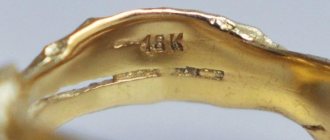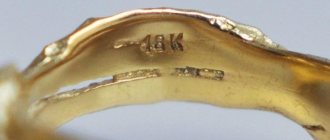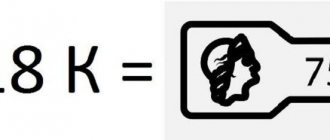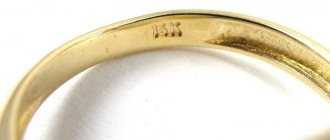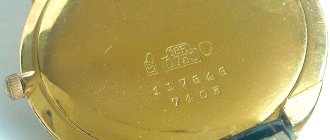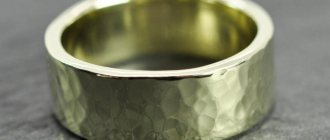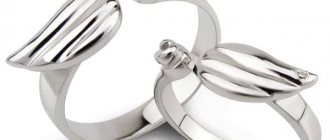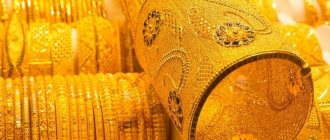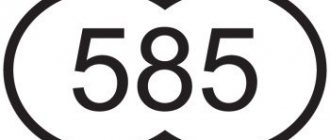Gold is a strong, wear-resistant metal with an incredibly beautiful appearance. The limited nature of its reserves creates a high cost of the metal, which tends to constantly increase. Many people are ready to invest their savings in the purchase of gold and products made from it, since such an investment has always been, is and will be profitable. But how can one not be mistaken about the authenticity of a metal and understand the systems for assessing it? For this purpose, the metric gold standard system and the carat system were developed.
What is carat
The term “carat” is used to indicate the weight of jewelry. The generally accepted abbreviation is ct. The weight of one carat is 200 mg. In England, this unit is used to determine the purity of gold. The higher the carat number, the fewer impurities in the metal. Depending on the alloy, metal is divided into 7 classes.
Origin of the word
The word "carat" comes from the Arabic qīrāt, the Latin carat, which means "carob pods". The plant was valued by jewelers in eastern countries. The fruits were distinguished by a constant shape, and the ancient masters called them “curatonia”.
The Egyptians, Romans, and Greeks were looking for a standard for comparing precious stones. This is how the comparison went with the seed, which weighed almost 200 mg.
Difference between gold and diamond carats
Gold is the amount of gold in a precious metal without impurities. The measure depends on the sample, which expresses the percentage of pure metal in the alloy.
A jewelry carat is the weight of a whole crystal. Unlike gold, the quality of which depends on the purity, for semi-precious stones this is a separate value. Therefore, precious stones are evaluated according to several criteria: clarity, color, cut.
Who tests
After production, all jewelry is sent to the Assay Office of Ukraine. After determining the content of precious metal in the alloy, they are branded with symbols of the sample (the content of the main precious metal). The Assay Chamber of Ukraine is responsible for applying the sample. The sample indicates the code of the assay office, as well as the digital designation of the sample.
When selling jewelry made of precious metals, all products must have the hallmark of the Assay Office of Ukraine.
Color
When it comes to color, 24k gold is an absolute winner, its tone being the actual color of real gold.
Any alloy with a lower purity will not have a true gold color, although 22 and 18 karat alloys are fairly close.
14K gold's yellow color is not as rich as 24K gold - the tone of 14K gold is paler in comparison.
However, its shade may vary depending on the presence of other metals in the alloy and their relative concentration. This is why you see 14k gold jewelry that is quite rich in color for the alloy of this purity.
The difference is cleanliness.
The biggest difference between 24 and 14 karat gold is purity.
The purity of gold is measured in karats. 1 carat is equal to 4.17% pure gold in the alloy.
Judging by the numbers - 24 and 14, the latter alloy is less pure. 14k gold is an alloy consisting of pure gold mixed with other metals.
The reason why such alloys are used is that pure gold is very soft and jewelry made from it bends and wears easily.
Typically, additional metals used in gold alloys are copper, zinc, nickel and silver.
24 carat is pure gold (999 fine). The maximum possible purity in carats is 24.
Therefore, 24 karat gold is 100% pure, while lower purity alloys have metallic impurities added deliberately.
14 carat is a gold alloy, that is, a mixture containing additional metals in addition to gold. These additional components are used to improve the characteristics of the alloy.
The most common additional components are copper, zinc, nickel, silver and palladium.
Some jewelers avoid nickel because it can cause allergic reactions in some people, especially if the metal is used in low-karat jewelry.
If you calculate the actual purity of 14 karat gold, it turns out that it contains 58.3% precious metal (14/24x) (585). The remaining 40% is copper, zinc, nickel, manganese, palladium, etc.
What is carat and fineness?
Nowadays, in order to determine the purity of a metal, two systems are used:
- metric system of samples;
- carat
The metric system is used in the CIS countries and Russia. The principle of the system: how much gold is in the alloy per thousand particles, this will be the sample. For example, a product made of 585 gold contains 585 particles of gold and 415 particles of alloy - impurities that make up the product. That is, one thousand grams of the alloy contains 585 grams of pure gold and 415 grams of impurities.
All other countries use the carat system; this gradation shows the ratio of gold and impurities in 24 parts of the alloy. That is, 24 karat gold is 100% pure gold. If we compare it with the Russian metric system, then this is 999 standard. Essentially, one carat is a fifth of a gram, or 200 mg of gold.
If you dive a little into history, the karate system was first used in Spain. But the very origin of the word “carat” comes from the name of the carob pod. Once upon a time, the seeds of this tree served as a measure of weight.
Ways to spot a fake
It often happens that unscrupulous jewelers try to deceive buyers and sell them, for example, jewelry made of silver instead of white gold. Moreover, to give the product a more attractive appearance, they can even cover it with precious metal. But that won't make it gold. There are several ways to help identify counterfeits:
- Bite the product. If it deforms easily, then most likely it is real gold.
- Knock two decorations against each other. There should be a slight ringing sound.
- Run the jewel over the tile surface. The gold will leave a yellow mark on the surface, otherwise black marks will appear on the product itself.
- Scrape the product from the inside. In this case, regular spraying will come off and other metal will be visible underneath.
- Try to attract the jewelry with a magnet. But this method will not allow one to distinguish gold from silver or copper, since all these metals are not attracted. But other impurities can be identified.
- Treat the product with a drop of iodine. Gold material will darken, and any other material will lighten.
In addition, it is important to know about the existing karat value of the metal . For example, a buyer should be very wary of the offer to purchase a product made of 21 carat gold. No matter what standard it is assigned to (and this is usually 875), such a number of carats is characteristic only of silver. If the seller claims a more precious origin, he is trying to sell a counterfeit product.
Any of the listed methods will not make it possible to accurately determine the composition of the jewelry if used separately. To understand the authenticity of a piece of jewelry, you need to try several, or better yet, all methods at once.
Jewelry and gold bars have always been considered a profitable investment. They will never depreciate in value and can be kept for a long time as a family heirloom. Therefore, it is very important to be able to distinguish low-quality goods from high-quality ones, as well as counterfeit goods from the original.
How to determine carat content
There are two systems used to indicate the purity of gold:
- carat;
- metric.
Carat determines the percentage of pure Au. The system is common in Great Britain, America, Switzerland and a number of other European countries. Among the British, 9-carat gold is popular, in the United States - 10, 14-18, India - 22, and the Chinese prefer 24 carats.
The purest alloy is 24 carats. To calculate the proportion of additives, you need to subtract the carat from 24. 9K contains 9 parts of gold and 15 additives.
How is 14k jewelry marked?
The easiest way to check the purity of gold jewelry is to look at markings, usually stamped in less visible places.
14 karat jewelry will most likely be o or "14 ct." Sometimes on jewelry you can see numbers expressed in parts per thousand.
The number used to denote 14 karat is 583 (which corresponds to 58.3% gold content), so if you see this stamp on a piece of gold jewelry, you can assume it is pure 14 karat.
Features of British carat gold
It is not an element of a strict system of weights and measures. Therefore, initially the gold carat, which is also called the British carat, was called non-systemic. Its name itself comes from the carob tree Ceratonia siliqua. This tree is widespread in Mediterranean countries. In ancient times, local residents noticed one interesting feature of the fruits of this evergreen plant: all its pods were always the same size and weight. People began to use this unique feature as a weight standard. During the heyday of the Roman Empire, the dry fruits of this tree were officially included in the system of measures. One unit corresponded to 0.19 grams, and this unit was called “siliqua”. Carat is the Greek name for siliqua, which spread throughout the world much later.
And here lies the main point that confuses many people. The carat, which traces its origins back to the Mediterranean wood, is used to measure the weight of diamonds, while the gold carat is not based on weight. Unlike its metric counterpart, which has a precise weight, the imperial gold alloy quality unit is a dimensionless value. It indicates the number of parts of pure gold in a particular product.
The maximum is 24 parts of the mass of the object. For example, it weighs 100 grams and is made of pure gold. In this case, to understand how many grams are in 1 carat of gold, you need to divide one hundred grams by 24. Thus, it turns out that one carat in a hundred-gram gold item can be equated to 4.1 grams, and depending on the weight of the item and its purity alloy this figure will change.
Due to the variability of British carat weights, no one uses weight as a guide. Take into account how many parts of pure gold are contained in the product.
So, if the 24-karat indicator indicates that the object consists of 100% precious metal, then in a 12-karat piece of jewelry it already accounts for 50%, and the remaining 50% are various ligatures. To find out the percentage of pure precious metal in a piece of jewelry, focus on one carat, which corresponds to 4.2%. For example, if you have an 18 carat piece of jewelry, simply multiply 18 by the percentage of one carat (4.2%) and you will get just over 75%.
So what is gold purity?
Sample (Probe German; Probo Lat. - I evaluate, test) - a unit of measurement, the percentage of precious metals: gold, silver, platinum, etc. The sample is indicated in a digital designation to understand the real amount of precious metal in jewelry, a precious coin or bar, where it is placed in the form of a hallmark and is strictly controlled by law.
There are four types of sample calculation systems: metric, spool, carat and lot. The most popular are the metric and carat systems.
What kind of sample is this?
24 carat gold is 999 fine. Why not 100%? There is no pure metal in nature. Refining, that is, the procedure for removing impurities, leaves only 0.01 percent of additives in the gold ore. 24 carats are considered elite.
A little about this test
The state gold reserve is formed from 24 carat metal. In Rus' it was called red for its red color when heated. To obtain the purest metal, the ore is subjected to an expensive refining process.
Strength
24 carat gold has a strength of 120 MPa. It is classified as a material subject to deformation. Expensive jewelry breaks under physical stress.
The metal is soft, marks remain on the surface if you run a knife across it. Melting point – 1063 degrees Celsius. The color of the molten metal is greenish. Aurum boils at 2947 °C.
Pure 24-karat gold is malleable and ductile. One gram can be rolled into foil with an area of 1 square. m or make 2.5 m of wire.
Alloy shade chart
The color of jewelry alloys depends on the type of impurities. 24 carats is a pure metal, there are practically no additives in it. Therefore, the color remains constant - bright yellow. The table shows the color change of Au with various impurities.
| Share of gold, % | Proportion of impurities, % | Main composition of impurities | Alloy color |
| 99,9 | 0,1 | Silver, palladium, platinum, copper | Yellow |
| 96,0 | 4 | Copper | Yellow |
| Copper | Red | ||
| 75,0 | 25,0 | Copper, silver, nickel; copper, silver | Yellow |
| Nickel, zinc, copper; palladium, silver, copper | White | ||
| 50,0–58,0 | 42–50 | Copper, silver | red |
| Silver, copper | Yellow | ||
| Silver, copper | Green | ||
| Nickel, silver, zinc, copper | White | ||
| 37,5 | 62,5 | Copper, silver | Red |
| Silver, palladium, copper | Pink |
Alloy shade chart
The color of jewelry alloys depends on the type of impurities. 24 carats is a pure metal, there are practically no additives in it. Therefore, the color remains constant - bright yellow. The table shows the color change of Au with various impurities.
| Share of gold, % | Proportion of impurities, % | Main composition of impurities | Alloy color |
| 99,9 | 0,1 | Silver, palladium, platinum, copper | Yellow |
| 96,0 | 4 | Copper | Yellow |
| Copper | Red | ||
| 75,0 | 25,0 | Copper, silver, nickel; copper, silver | Yellow |
| Nickel, zinc, copper; palladium, silver, copper | White | ||
| 50,0–58,0 | 42–50 | Copper, silver | red |
| Silver, copper | Yellow | ||
| Silver, copper | Green | ||
| Nickel, silver, zinc, copper | White | ||
| 37,5 | 62,5 | Copper, silver | Red |
| Silver, palladium, copper | Pink |
What is the cost of 14k gold?
The value of your jewelry depends on how much buyers are willing to pay for it.
Here we discuss the value of gold jewelry that is sold only as scrap. However, retail prices for new jewelry depend on more than just the amount of pure gold it contains; Factors such as the design and brand of the jewelry also play a role.
One way to estimate the value of 14k gold is to look at its market prices. Another way is to find out what dealers are paying per ounce or gram.
Market price
The current market price can be found from various sources online and fluctuates from day to day.
You should not expect to get the same price if you sell your jewelry to a dealer. These buyers typically pay around 70%-80% of the market price you see on international exchanges.
Dealer price
Dealers buy jewelry and other items to sell as scrap to recycling plants or to melt them down before resale.
To get a realistic idea of how much money you can get for your 14 karat jewelry, check out the prices quoted by a number of dealers.
As mentioned, you should expect dealers to pay approximately 20% less per gram of pure gold for jewelry than the market price.
Can you get more money for 14k gold??
The above guidelines will be important to you if you are thinking of selling your jewelry as scrap.
However, if your gold items have antique value, a unique design, or are valuable collectibles, you could try selling them at an online auction to get more money.
Another option is to offer the jewelry to a jewelry store, which can either pay you cash or take the cost of the piece into consideration when purchasing a new one.
How much does 1 gram of gold of this standard cost?
Gold has long become a hard currency; it is used to carry out payment transactions and evaluate the official reserve assets of states (gold and foreign exchange reserves). To calculate the bank value, you need to multiply 0.585 by the figure established by the Central Bank, but the price in stores and pawn shops may differ significantly.
| Price 999 standard according to the Central Bank | Market value of the sample today | Scrap price | Price in jewelry |
| 3857 rub. | 3853 rub. | 3468 rub. | 4050 rub. |
Scope of gold, 999 purity
Due to the fact that pure metal is very soft, it is rarely used to create jewelry. Most often, massive rings are created, weighing about 10 grams. Such bulkiness is a necessary measure, otherwise the rings will be easy to deform, even when putting them on. Pure metal has gained great popularity in the investment field. Bullions weighing from 1 kilogram are an excellent deposit, the value of which is constantly growing. Most of the countries' gold and foreign exchange savings are represented by .999 gold bars. The deposits of wealthy people are also very often represented by gold bars. In ancient times, rings, earrings, bracelets and others were created from pure gold. It was also used to cover the domes of churches, which protected them from corrosion. With the development of metalworking, alloys with alloys began to appear, and pure metal began to fade into the background.
Interesting fact. The greatest demand for products made from 24 carat metal is observed in Arab countries. The need to carefully monitor products does not stop residents of this region from buying jewelry. The main thing is the high purity of the alloy and high-quality jewelry work.
Differences in hardness.
The different purities of 24 and 14 karat alloys result in different levels of hardness, which is why the alloys are used for different types of jewelry.
14K gold is used to make durable jewelry.
14K gold is relatively hard, making it a popular alloy. This characteristic makes 14k gold products more durable.
Jewelry made from this type of gold scratches less and lasts longer because it wears out more slowly than an alloy containing a higher percentage of the precious metal.
24k gold is too soft for jewelry and is very rarely used because the metal is so soft.
As a result, it can be easily scratched and easily deformed.
For example, a ring made of pure gold will be too susceptible to damage and parts (such as the teeth of the setting) will wear off very quickly.
Caring for your decoration
Although the alloy is considered the strongest metal, it requires special care. Items must be stored in a dry place. If the owner of the product encounters chemicals at work, it is better not to wear gold jewelry. To ensure that the item is scratch-free, it must be stored in a special soft box. You should periodically check the condition of the jewelry and the integrity of its clasps. If there is the slightest malfunction, you need to take the gold item to a jeweler for inspection.
| Metric system | Carat system |
| 1000 | 24 |
| 958 | 23 |
| 916 | 22 |
| 750 | 18 |
| 585 | 14 |
As a result, 750 alloys are what most buyers settle on. This product is affordable, beautiful and will last a long time.
How many carats is 750 hallmark?
In the Western karat system, 750 is 18 karat gold. As you know, Europeans prefer white or yellow gold to red. If we talk about ancient samples of the 18th-19th centuries, then 750 sample is 72 sample measured in spools.
Interesting materials:
How can I shuffle songs in a folder? How can you transfer Cornflower? How can you tell fortunes for your betrothed? How can you get glucose? How can I get crystals in Clash of Clans? How can you congratulate you on your silver wedding? How can you complain about a company to the tax office? How can you stick paper to glass? How can you widen your sandals? How can you stretch a shrunken sweater?
A little about samples
999 standard or 24 carats is considered the purest gold, the percentage of impurities in which is no more than 0.1%. To put it in the old fashioned way - “red”. It is highly fragile and bends easily, which is why it cannot be used in jewelry. But on the other hand, before the October Revolution of 1917 in Russia, wedding rings were made from it, which were also in demand among the “new Russians” in the 90s; they were very thick and massive, weighing about 8 grams or more. The price for 999 samples is, logically, the highest.
375 is considered one of the lowest quality in the world. 9 carat gold, if you calculate what standard it will be equal to, is closest to 375.
Sample 375 is unpopular in Russia.
At the moment, you can only find one alloy that is even lower quality - 333 or 8K.
In the Russian Federation, 375 sample is a very rare guest. It is rarely used in the jewelry industry. For this reason, on the shelves of domestic stores it is found in the minimum list of products.
The low content of pure gold in such jewelry does not have the best effect on the brightness of the surface and does not attract potential buyers. Moreover, some people experience allergic reactions when wearing such products due to impurities in the alloy.
What hallmark is 10 karat gold? In fact, this question misleads many people. 10K is somewhere between 375 and 585, containing 416 grams per kg of pure aurum. Thus, 10 carat gold is of low quality, and it is impossible to say exactly what standard it corresponds to on the Russian market, because we do not have 416 in use.
Composition of popular gold alloys
The most common variant of gold in Western countries is 14 karat alloy. It corresponds to our 583rd or 585th sample, which is the most common in the post-Soviet space. This gold alloy has good casting and strength characteristics, which makes it possible to create jewelry from it for everyday wear.
Depending on the number of certain ligatures in the composition, 14 carat gold can have different shades. For example, if it contains about 36% silver and 5.5% copper, then the master will end up with gold jewelry with a greenish tint. If silver in the alloy accounts for 18.3% of silver, and copper about 23.5%, then the popular pink color can be created. But if the amount of copper is increased to 33.5%, and silver is reduced to 8.4%, then a gold product will come out with a distinct reddish tint.
White gold, popular in the West and in our country, is most often made from 14-karat and 18-karat alloys. In the first case, the alloy contains about 23–28% silver, 13–18% palladium or 17% nickel. Copper is found in different versions, but not more than 16%, as well as zinc - about 9%. But in 18-karat gold the following alloys are found: silver (7-15%), palladium (14%), nickel (4%) or zinc (2-5%), copper (15%), nickel (7-16 %). In more expensive options, zinc and copper are not added to the alloy, and rhodium and platinum are used as alloys, but the cost of such jewelry is much higher. In addition, not all countries add nickel to white gold. For example, in the European Union countries, the use of this ligature in jewelry is prohibited at the legislative level, since in some cases it causes allergic reactions in people.
Jewelry with a carat value of 10 or less corresponds to our 375 grade. This alloy contains only 37.5% pure gold, and the lion's share is copper - about 49%. Also, the alloy may contain about ten percent silver and about four percent palladium. Wedding rings are made from similar alloys, the prices of which are affordable. But due to the low content of precious metal in them, such products are not in great demand.
When choosing jewelry marked according to the karat system, you need to be able to recognize real gold and gilding, since it is easy to get confused in their designations.
If on the surface of the jewelry you have chosen you see numbers with a capital letter “K”, for example, “18K”, this means that this means that this is a high-grade gold product corresponding to the 750th standard. But if you find numbers with the letters “KGP” on the jewelry, you should be alert, since this is a gold-plated object. For example, if you see the marking “22KGP”, this means that the gilding contains 916-carat gold, but the item itself is made of a different metal. The abbreviation itself, following the numbers, means the English phrase “karat gold plated”, which translates as “covered with gold in so many carats”.
Sample purity
Samples can be converted to the karat system. The purest standard used in jewelry is 958. It corresponds to 23 carats. Impurities here are necessary to change the properties of the material towards greater strength. 22 carats is 917, also quite pure. 18 carat or 750 standard is a traditional type of alloy that allows you to create a balanced alloy with other metals. It is this numerical indicator that can be called optimal. 14 carat - 585 gold. It is very common both in Russia and in Europe. Due to the large percentage of impurities, it can obtain an original shade, and also has sufficient hardness for various jewelry manipulations - twisting, stretching, straightening to the state of a sheet. 10 carats is 416 fine, and just over 40% pure gold. This is the lowest metal purity standard in the United States. In Russia, 375 fineness of 9 carats is also acceptable. In the East, the 8-carat marking, containing 33.3% gold, is also used. To convert gold in carats and convert it to the metric system, the table below may be useful:
Carat value on gold products
Some Western countries have adopted a karat system for gold samples, including values from 24 to 9 carats.
| Designation in carats | What mass of gold from the total weight of the alloy does this correspond to? |
| When asked how many carats are in pure gold, the largest value of this system is 24. | It indicates that this is gold metal in its pure form. |
| Next comes 23 carats. | This figure means that the weight of gold in the item is 0.958, used in a luxury item. |
| Mark 22. | She talks about the mass of gold being 0.916 of the total weight of the alloy. |
| Which is typical for 21 carats. | Mass index 0.875. |
| 18 carats. | Here the mass of gold is 0.750 of the total weight of the precious alloy. |
| Which is 14 carats. | There is 0.583 parts of gold present. |
| In 12 carats. | 0,500. |
| And at 9 carats. | Just 0.375. |
All jewelry with a carat value between 24 and 18 is considered high-grade. The numbers 14 and 12 indicate gold jewelry of the average group in terms of standard. And everything that is below these indicators is perceived by experts as low-grade gold.
To easily convert the carat system to the metric system, you need to use the following ratio: 24/1000 = X/Y.
In this formula, X corresponds to carats, Y to metric standards. To convert carats to the usual standard, use the formula:
Y = 1000 * X/24
For example, if you see a product in front of you with 14K on it, then to convert this value into a sample, you need to multiply a thousand by 14 and divide by 24. As a result, you will get 583 samples. Now our jewelers do not produce gold jewelry with this hallmark, but in Soviet times it was the most common. Now it has been replaced by a higher quality 585 sample.
24-karat gold is very soft and fragile, and therefore it is rarely used in jewelry and in very limited quantities. The situation is similar with precious alloys in the range from 23 to 21 carats. All of them have three components:
- gold;
- silver;
- copper.
But the amount of alloys added to the alloy is different. 21k gold is often used to create engagement rings as the alloy is relatively durable and can withstand frequent use. At the same time, it is characterized by a bright yellow radiance, characteristic of pure precious metal. Products marked at 18 carats are also created from three-component alloys. In different versions, in addition to gold, silver and copper, they may also contain the following metals:
- rhodium;
- zinc;
- nickel;
- palladium;
- platinum.
This precious alloy lends itself perfectly to melting and further processing, which is why jewelry makers love it. It is an excellent base for applying jewelry enamel to its surface. But in this option, it is important that copper in the gold alloy should account for no more than 15–16%, otherwise the color of the enamel will fade. 18-karat gold is used to create fine jewelry with a relief or openwork surface. It is strong enough to hold fragile gems in jewelry or diamonds well.
Difference between 14 and 24 carats
The most important difference between the metals of these samples is the content of impurities. For 24 carats, according to GOST No. 30649-99, the ligature does not exceed 0.1%, for 14K – 41–41.5%. This means that the highest sample consists of almost 100 percent Au, and 585 - only 58.5%.
Color and price
Color 24K – bright yellow. The authenticity of coins and chervonets was checked using heating. If the color was red, then the metal was clean. As the gold cools, it acquires its primary color. Due to the small amount of impurities, the color does not change.
14K metal has a wider color palette. A high content of copper gives a red tint, silver and copper - yellow, silver - green.
The price of samples differs significantly: the average price of a gram of 24 carats is 2500 rubles, 14K is 1600 rubles.
How to evaluate 14 karat gold?
Let's take a look at what factors influence the value of 14k purity gold jewelry and how you can estimate its value.
The value of a gold alloy depends on the amount of pure gold it contains. This means that in order to determine how much a 14k piece is worth (when sold as scrap), you need to find out its weight and, taking into account the purity of the alloy, determine the amount of pure gold it contains.
Once you know this, you can use current market prices to value it.
Let's see how you can determine the amount of precious metal in a 14-karat piece:
Weigh the product
Place your product on the scale.
Be sure to remove any other items—for example, if you're weighing jewelry with gemstones, don't take their weight into account.
Many jewelers use troy ounces and pennyweights to indicate weight (1 ounce = 20 pennyweights), so if you weigh your jewelry in grams or ounces, you may find these conversions helpful:
1 gram = 0.03215 troy ounce
1 gram = 0.64301 pennyweight 1 ounce = 0.91146 troy ounce
1 ounce = 18.22917 pennyweight
Calculate the amount of pure gold a
Now that you know how much your gold jewelry weighs, you can calculate how much pure gold it contains.
14K contains 14 parts pure gold and 10 parts other metals. This means that 58.3% of this alloy is gold (14/24 x 100). So you simply need to multiply the weight of your items by this percentage to find the precious metal content.
For example, if you have 5 grams of 14K gold, then it should contain 2.915 grams of pure gold (5 x 58.3%).
How to check the cleanliness of products?
Typically, gold jewelry is marked with a carat value. In the absence of samples and stamps, or if it is necessary to check the purity of the product, various methods can be used.
Acid testing
Performed by a craftsman in most jewelry stores. The product is scratched and a little acid (mostly nitric) is applied to this place to produce a chemical reaction. It is used to determine the carat size. You can carry out testing yourself using a special kit with nitric acid included.
The test is usually performed as follows.
- Lightly scratch the product on the non-visible side.
- The kit includes bottles of acid of different concentrations, with the carat number indicated on each label. You need to drop acid from a bottle with the lowest number onto the scratch and evaluate the reaction.
- If the carat of the alloy exceeds that indicated on the label, the color of the metal on the mark will remain unchanged. In this case, you need to repeat the manipulation, using the acid from the bottle with the next lowest number.
- If the carat matches the number on the label, the location of the mark will slightly change its color. If the jewelry is 1-2 carats less, the mark will rust slightly, but will remain intact.
- If the carat is more than one lower than what is indicated on the label, the mark will dissolve and disappear.
Before you begin acid testing, it is important to carefully read the instructions included with the kit. The exact procedure may not be the same as the method described above.
Other ways to check the purity of the alloy
There are metal cleanliness tests that have become popular. But despite this, they are useless.
You should not bite a gold item, although they say that this is a good way to determine the authenticity of gold. Not only is it a soft metal, there are other soft alloys that are simply plated with gold. Unscrupulous counterfeit sellers often take advantage of this.
It is also believed that gold does not attract magnets, which proves its purity and authenticity. At the same time, there are many alloys that also do not react to magnets. They may just be gold plated.
The best way to determine the cleanliness of a product is to test it with acid on the mark.
How to distinguish gold from gilding
Counterfeiting of jewelry and high-quality items is common. The Assay Office claims that 15% of all products are counterfeited annually. Basically, products made of silver, copper, brass, coated with a thin layer of 24 carat gold are passed off as noble metal. To avoid falling into the trap of scammers, use these tips:
- Before visiting a store or pawnshop, stock up on a magnifying glass. It will help you better see the mark on the product. This aurum must be marked with the Assay Supervision Inspectorate indicating the sample. Gilded items do not have a hallmark or receive a base metal marker.
- Pay attention to the edges of the jewelry: gilding is a thin gold coating on an item made of any metal. It tends to wear off over time. If the color is uneven, then the item is not completely gold.
- Stock up on a magnet. 24 carat metal is diamagnetic and will not attract. But the impurities may include alloys that are attracted by a magnet.
- Each ingot must have a certificate and passport.
You can have your metal checked without leaving the store. The main thing is not to damage precious products!
Next, we suggest watching an interesting video about how you can check gold for authenticity at home:
Foreign gold and gilding - consider the difference
Foreign gold purchased in jewelry stores in Italy, Turkey, China and other countries does not always meet Russian standards, or in other words, it cannot be considered a quality product. Most often, such gold is imported illegally, bypassing both customs control and state control authorities.
According to statistics, seventy percent of gold imported from abroad is fake, so you need to be very vigilant when choosing foreign jewelry.
It must be remembered that foreign products, even if they are genuine, differ from Russian ones in shade and composition; the vast majority of jewelry is yellow or white, with a minimal copper content.
Sources
- https://zolotoe-runo-sl.ru/proba/24-karatnoe-zoloto-cena.html
- https://zhazhdazolota.ru/proby/24-karata
- https://JewelryExpert.ru/interesno/1-karat-ehto-skolko.html
- https://DedPodaril.com/zoloto/klejma/24-karata-zolota-eto-skolko.html
- https://grammzolota.ru/proby/proba-karatah.html
- https://goldomania.ru/articles/assay_gold.html
- https://wvape.ru/proby-i-splavy/21-karat.html
- https://TokyoStreet.ru/dragocennye-kamni/24-karatnoe-zoloto.html
- https://art-posh.ru/yuvelir-info/23-karata-zolota.html
- https://golden-inform.ru/proby/karat-zolota-v-grammah/
- https://vplate.ru/zoloto/vse-o-karatnosti/
- https://golden-inform.ru/proby/zoloto-24-karata-kakaja/

